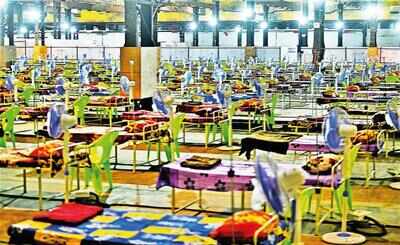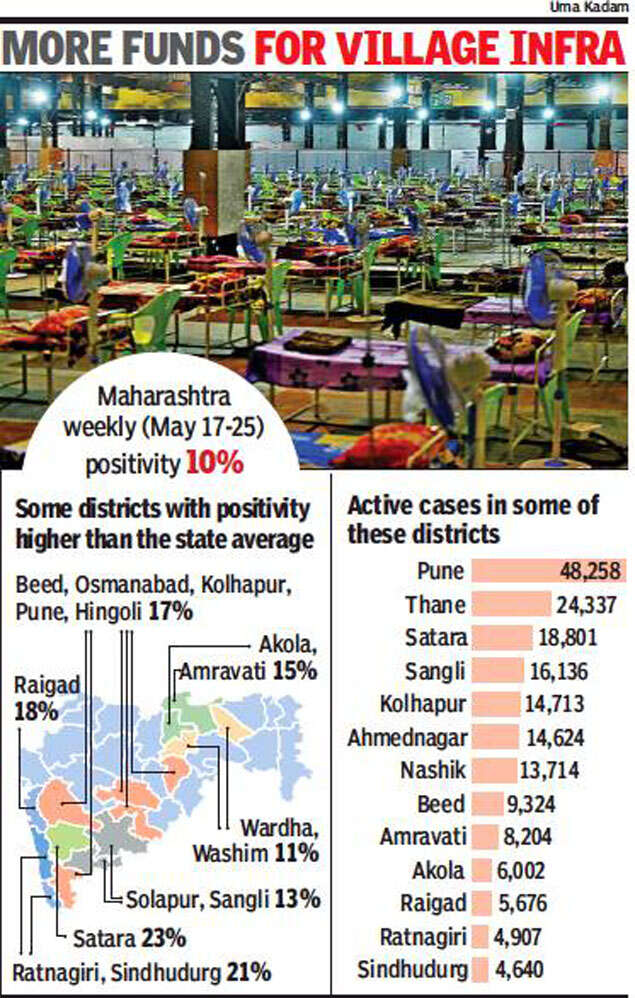Top Searches
- News
- City News
- mumbai News
- Covid-19: Maharashtra pushes institutional isolation in 18 districts with high case positivity
Covid-19: Maharashtra pushes institutional isolation in 18 districts with high case positivity

The announcement had come as a surprise because no district would have that many beds in Covid Care Centres (CCCs). (Representative Image)
MUMBAI: Hours after announcing the end of home isolation in districts with a positivity rate higher than the state’s average on Tuesday, the state government softened its stand saying it will be discouraged and the emphasis will be on institutional quarantine.
Of the 36 districts in the state, the weekly positivity rate of 18 districts is higher than the state’s weekly average of 10% .

In a review meeting chaired by deputy chief minister Ajit Pawar, it was decided home isolation of Covid patients in these districts should be discouraged and Covid centres should be scaled up to accommodate more patients. The centres will be set up at the village level, and the state allowed districts to spend 25% funds from the grants received under the15th finance commission and also revenue generated by the minor mineral development fund. “The number of patients in home isolation in these 18 districts should be brought down to negligible. We have realised monitoring in home isolation is not effective and the infection spreads to the other family members as well,” said health minister Rajesh Tope after the meeting.
He added: “Testing has to be done in a focused manner. Once a person tests positive, all the high and low risks persons should be tested diligently. The state has asked the collectors of the 18 districts to avoid random testing in a large number to artificially lower the positivity rate.”
Earlier in the day, Tope had said the state government will completely stop home isolation in these districts. “The announcement had come as a surprise because no district would have that many beds in Covid Care Centres (CCCs). Even now, there is careful selection of patients to be admitted to CCCs given the manpower and infrastructure constraints,” a senior official told TOI.
Theoretically, only institutional isolation would have been a good approach, said Sangli civic surgeon Dr Sanjay Salunkhe, but added it would be nearly impossible to implement. Besides manpower and infrastructure, there was the issue of hesitancy. People would have started avoiding the testing that has been ramped up in these districts.
Salunkhe added: “The fact is families are not able to follow home isolation. They continue to share toilets, washing facilities.” Home isolation could have been an option in the first wave when the district peaked at 1,174 cases. “In the second wave, we had peaked at 2,300 cases on May 7, but still continue to see 1,400-1,500 cases daily,” he said, adding that the thick tail would mean hospitals would be overwhelmed in a day.
Officials said due to lack of monitoring in these districts, the death rate too is going up. “Many patients who are in home isolation are coming to hospital in really bad condition,” said an official.
A senior doctor from Gondia Medical College said institutional isolation is the fundamental way to treat an infectious disease. “But the numbers are so overwhelming at present, it’s not a practical solution,” he said. One of the ways to curb the rise in cases is to increase testing in a big way. “But often GPs and community doctors are not recommending it,” he said. At least three districts have over 20% positivity, which means their testing needs to increase four to five fold.
Of the 36 districts in the state, the weekly positivity rate of 18 districts is higher than the state’s weekly average of 10% .

In a review meeting chaired by deputy chief minister Ajit Pawar, it was decided home isolation of Covid patients in these districts should be discouraged and Covid centres should be scaled up to accommodate more patients. The centres will be set up at the village level, and the state allowed districts to spend 25% funds from the grants received under the15th finance commission and also revenue generated by the minor mineral development fund. “The number of patients in home isolation in these 18 districts should be brought down to negligible. We have realised monitoring in home isolation is not effective and the infection spreads to the other family members as well,” said health minister Rajesh Tope after the meeting.
He added: “Testing has to be done in a focused manner. Once a person tests positive, all the high and low risks persons should be tested diligently. The state has asked the collectors of the 18 districts to avoid random testing in a large number to artificially lower the positivity rate.”
Earlier in the day, Tope had said the state government will completely stop home isolation in these districts. “The announcement had come as a surprise because no district would have that many beds in Covid Care Centres (CCCs). Even now, there is careful selection of patients to be admitted to CCCs given the manpower and infrastructure constraints,” a senior official told TOI.
Theoretically, only institutional isolation would have been a good approach, said Sangli civic surgeon Dr Sanjay Salunkhe, but added it would be nearly impossible to implement. Besides manpower and infrastructure, there was the issue of hesitancy. People would have started avoiding the testing that has been ramped up in these districts.
Salunkhe added: “The fact is families are not able to follow home isolation. They continue to share toilets, washing facilities.” Home isolation could have been an option in the first wave when the district peaked at 1,174 cases. “In the second wave, we had peaked at 2,300 cases on May 7, but still continue to see 1,400-1,500 cases daily,” he said, adding that the thick tail would mean hospitals would be overwhelmed in a day.
Officials said due to lack of monitoring in these districts, the death rate too is going up. “Many patients who are in home isolation are coming to hospital in really bad condition,” said an official.
A senior doctor from Gondia Medical College said institutional isolation is the fundamental way to treat an infectious disease. “But the numbers are so overwhelming at present, it’s not a practical solution,” he said. One of the ways to curb the rise in cases is to increase testing in a big way. “But often GPs and community doctors are not recommending it,” he said. At least three districts have over 20% positivity, which means their testing needs to increase four to five fold.
FacebookTwitterLinkedinEMail
Start a Conversation
end of article
